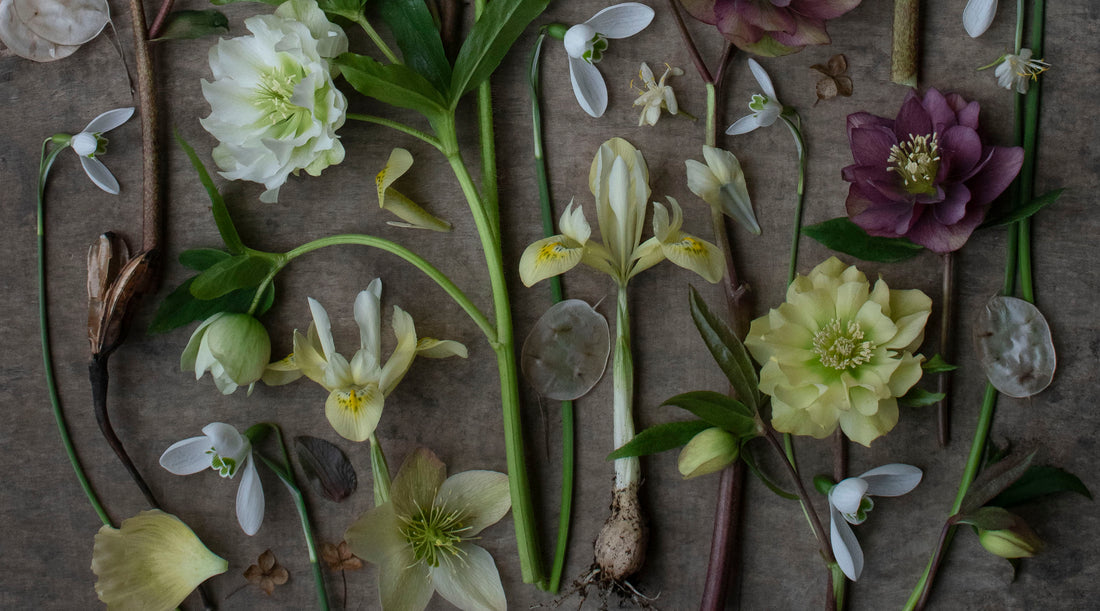In the depths of winter, one of my favourite things is to go looking for botanical treasure. In an otherwise unpromising, bare-looking garden, I’m usually trying to find something of interest that can be worked into a new photograph. I’m often delighted by the flowers and seed-heads waiting to be discovered. On the day this picture (below, left) was taken, I got myself a pretty good haul, but even so, this is a time of year when every flower seems valuable and precious. So the sparse layout goes some way to reflecting this.

The picture above (January No.1), serves as a snapshot of the plants we can add to our gardens for a dose of delight in winter. All of the flowers were grown outdoors apart from the Icelandic Poppies which were the very first to open in the glasshouse. There are two poppies in this picture: one fully open (top and centre), and its still-crumpled companion just to its right. The bulb of the sweet, yet striking Iris reticulata ‘Katharine’s Gold’ was carefully dislodged from the soil of its terracotta pot and, once the picture had been taken, tucked back in… Although it has to be said, the petals never quite regained their original perfection.
These compilation photographs tend to take several hours to get right and, although I like to preserve as many flowers as possible to enjoy in a vase afterwards, the petals often end up in a bit of a sorry state! The hellebores survived pretty well. I prefer to float their heads in a bowl of water - it’s one of the most beautiful and easy ways to enjoy them in the house. Hellebores are notoriously tricky to keep upright in a vase, due to a lack of lignin in their stems (though I won’t get into that right now). Although there are techniques to counteract this, I like to avoid the hassle by floating them, which gives me a chance to study the centre of their flowers. Displayed on a side-table or deep windowsill beside a candle on a cold winter’s evening, and you have something resembling a little makeshift seasonal altar… Or at least that’s how it feels to me! The more ruffled, semi-double varieties in this print are from the ‘Lady Series’, and the singles are Helleborus x ericsmithii ‘Emma’.
As for the particular variety of snowdrop in the print, I’m not sure which it is, but I love the simplicity of its shape and the light it brings to the image. On Valentine’s Day last year, my tween-age nieces visited and, on our lunch-table, alongside the food, the hellebores and the pink lemonade, I placed tiny vases of snowdrops picked earlier that day. This is the true Valentine’s Day flower - beautiful, precious, robust, delicate and perennial. If space allows, they’re easy to grow in huge quantities too, providing handfuls for gifting to a loved one. My youngest niece declared the lunch to be as good as any fancy London restaurant! How she knows is a mystery but I took it as a great compliment.

Take another look at the print and you’ll spot one woody stem with pale pink, globe-like buds in the upper left-hand section. This is Chaenomeles x superba ‘Pink Lady’, a flowering quince, whose stems can be cut when the flowers are in bud and left to open up in a vase. It is a beautiful thing to witness this over the course of a couple of weeks. Just one stem is required, all the better for its simplicity.
In the gardens where I’ve worked, I always leave lots of seed-heads standing from the previous year. Between late January and late February, they are cut back to the ground. This is a good habit to get into, providing additional shelter and a food source for birds and insects. The visual effect is very beautiful too. The seed-heads of some lilies can be particularly lovely, having what seems like an unnecessarily beautiful copper finish to the inside of their casings. If you’re lucky enough to find a large one intact, they make a wonderful temporary ornament for a windowsill. I like to use them in my photography at this time of year, though I must admit that the pair in this picture aren’t the most spectacular I’ve seen.
As for the other seed-heads in the print, these are Lunaria (aka Honesty) which, by this time of year, are at their most delicate and translucent. There are also the fragile remnants of hydrangea flowers, still clinging on after all the weather winter has thrown at them. Last but not least, there are the flowers of winter honeysuckle (Lonicera fragrantissima), which might be considered a fairly unremarkable shrub were it not for these fragrant winter blooms.
So there we have it, a whole lot of joy from the garden in winter. If you don’t yet have these beauties in your own garden (if you have one), I’d definitely recommend adding one or two.
Becky x


